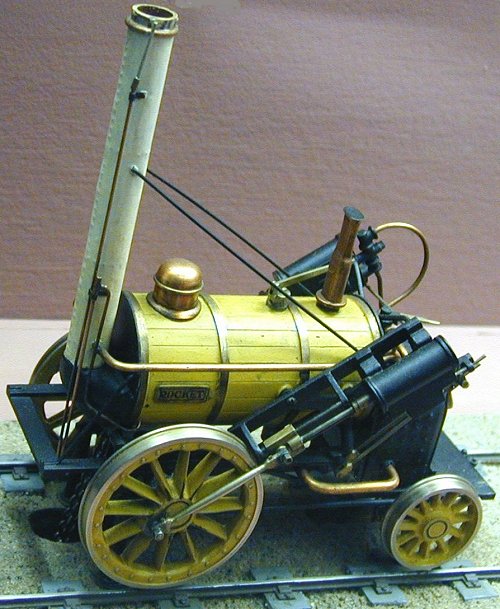Recoil Propulsion
Today, jets and rockets. The University of Houston's College of Engineering presents this series about the machines that make our civilization run, and the people whose ingenuity created them.
In the late eighteenth century, William Congreve learned about the Indian Army's rockets. When he realized that their launching platform didn't feel any recoil, he saw a perfect weapon for British warships. He invented a greatly improved version -- the rockets whose red glare we sing about at baseball games.
His rockets didn't do much harm at Fort McHenry. Explosive shells with timed fuses, "the bombs bursting in air," were the real problem. But Congreve rockets were a fine example of the recoil propulsion idea, which had seriously begun tickling people's minds.

Congreve rocket fired in the Battle of Stonington, August 9-12, 1814, by the British ship Terror.(Stonington Lighthouse Museum, Stonington, CT.)
As early as 1720, Dutch scientist Jacob Willem 'sGravesande, proposed a vehicle driven, not by rocket power, but by a backward facing jet of steam. It was never built, but the idea of shooting something out the back, to send one forward, lingered on.
Later in the century, Ben Franklin proposed making a boat with a hand pump to draw water in through a forward-facing pipe, and out a jet facing to the rear. That idea re-emerged in the 1780s when two competing inventors worked on the development of steamboats.
One was John Fitch. In 1790 he ran the first commercial steamboat service, between Philadelphia and Trenton. He used paddles, but his competitor, James Rumsey, adopted Ben Franklin's idea. Rumsey replaced the hand pump with a steam engine, and his boat actually did run. It potted along quietly at about three miles-an-hour on a demonstration run. Unfortunately, his boiler leaked, and he never was able to get it quite right.
So the idea of jet propulsion, or rocket propulsion, or any form of recoil propulsion, teased people; it ignited our dreams of speed. Finally, in 1829, came a defining moment in the quest for faster transport. Steam locomotives had been brought to commercial use, but questions remained as how best to move loads on rails.
The embryonic Liverpool and Manchester railway finally sought to resolve the matter with a contest. They held the so-called Rainhill Trials with a £500 purse. There were tests for hauling capacity, for the ability to negotiate grade, and for speed. Three entrants finally made it to the trials and only one finished them. He was Robert Stephenson. His engine was a fine success and it reached the astonishing speed of thirty miles an hour.
Now the odd part: Stephenson named his engine The Rocket. Was he thinking of celebratory fireworks? Was he thinking of Congreve's war rockets? We can only be sure that he was thinking of speed. That is ironic, because no recoil propulsion system has ever been successful at speeds that low.
Locomotives went on to move faster and faster until, in 1893, the Empire State Express was clocked at 113 miles-an-hour, a speed no airplane would match until WW-I. By then, Congreve's rockets had given way to rifled artillery, and were pretty well forgotten. We wouldn't move at speeds like theirs until recoil propulsion came back -- until we had jet airplanes and space travel.
I'm John Lienhard, at the University of Houston, where we're interested in the way inventive minds work.
A. R. Hall, 'sGravesande, Willem Jacob. Dictionary of Scientific Biography. Vol. V (C.C. Gilespie, ed.), Chas. Scribner's Sons, 1972.
W. von Braun and F. I. Ordway, III, History of Rocketry & Space Travel, (revised ed.) New York: Thomas Y. Cromwell Co., 1969. See also, F. H. Winter, The First Golden Age of Rocketry, Washington, D.C.: The Smithsonian Inst. Press, 1990.
Sutcliffe, Steam: The Untold Story of America's First Great Invention. (New York: Palgrave Macmillan, 2004).
J. T. Flexner, Steamboats Come True: American Inventors in Action. Boston: Little, Brown and Company, 1944/1978.
S. Smiles, The Story of the Life of George Stephenson, Railway Engineer.London: John Murray, Albemarle Street, 1859.

Stephenson's Rocket. (Scale model in the Boston Museum of Science)

Empire State Express No. 999 (Chicago Museum of Science and Industry)
All photos by John Lienhard.